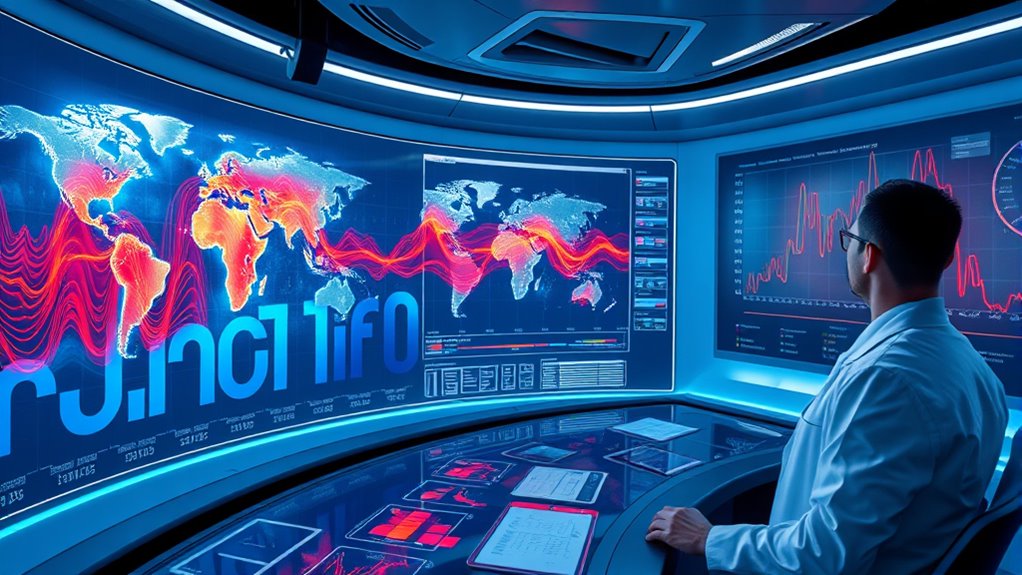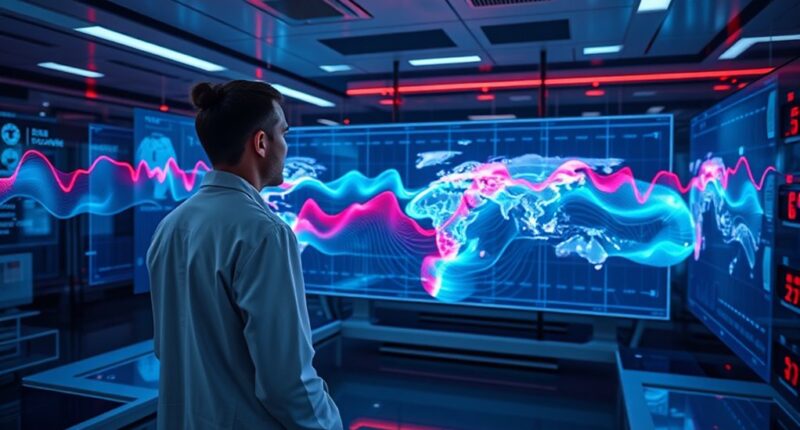AI predicts earthquakes by analyzing data from advanced seismic sensors and combining it with geological and satellite information. Machine learning algorithms quickly spot patterns and anomalies in ground vibrations, stress levels, and historical data, giving you early warnings hours or days ahead. This integrated approach helps improve accuracy and response times. If you want to understand how these technologies work together, keep exploring how researchers are refining these predictive systems.
Key Takeaways
- AI analyzes real-time seismic sensor data to detect early ground movement patterns indicative of potential earthquakes.
- Machine learning models identify anomalies and stress signals by correlating diverse data sources like geological surveys and satellite images.
- AI continuously learns and improves prediction accuracy by adapting to new seismic data over time.
- Integration of seismic sensors, historical records, and satellite data enhances the ability to forecast quakes before they occur.
- AI-driven systems aim to provide early warnings hours or days in advance, improving preparedness and safety measures.

Can artificial intelligence truly predict earthquakes before they happen? That’s the question many are asking as scientists harness advanced technology to improve early warning systems. Traditionally, predicting earthquakes relied on understanding fault lines and monitoring seismic activity, but it’s never been precise enough to give reliable alerts. Now, with the help of seismic sensors and machine learning models, researchers are making strides toward more accurate predictions. These seismic sensors are scattered across fault zones, collecting real-time data on ground movements, vibrations, and stress levels. They act like the nervous system of the Earth, constantly sending streams of data that can reveal subtle patterns indicating an impending quake.
Seismic sensors monitor ground movements in real-time, revealing subtle patterns that may signal an upcoming earthquake.
The real breakthrough comes when this wealth of sensor data is fed into machine learning models. These models analyze vast amounts of information far faster than any human could, identifying correlations and anomalies that might signal an upcoming seismic event. Unlike traditional methods that rely on predefined thresholds, machine learning models adapt and learn from new data, improving their accuracy over time. For example, when minor tremors or unusual stress signals are detected, the models can assess the likelihood of a larger quake in the near future. This process allows scientists to issue warnings hours or even days in advance, providing valuable time for communities to prepare and evacuate if necessary.
However, predicting earthquakes isn’t just about having the right sensors and algorithms. It’s also about understanding the complex behavior of the Earth’s crust. Seismic sensors capture a snapshot of ongoing activity, but the Earth’s interior is incredibly intricate, with numerous variables influencing the timing and magnitude of quakes. Machine learning models are designed to handle this complexity by integrating diverse data sources—such as geological surveys, historical seismic records, and satellite imagery—to build a thorough picture. This multi-layered approach helps improve the models’ predictive capabilities, making early warnings more reliable.
Despite these advances, challenges remain. Earthquakes are inherently unpredictable, and even the best models can’t guarantee perfect forecasts. But with continued refinement of seismic sensors and machine learning algorithms, you’re increasingly getting closer to a future where earthquake predictions are more timely and accurate. This progress doesn’t just save money or property; it saves lives. As AI evolves, so does our ability to anticipate nature’s most devastating events, turning data and technology into tools of resilience and preparedness.
Frequently Asked Questions
Can AI Predict Earthquakes Years in Advance?
You wonder if AI can predict earthquakes years ahead. While AI isn’t yet capable of precise long-term forecasts, it uses seismic sensor networks and geological modeling to analyze data and identify patterns. These tools help scientists understand earthquake risks better, but predicting exact events years in advance remains a challenge. Your best bet is to stay informed about ongoing research improving early warning systems with AI’s aid.
How Accurate Are AI Earthquake Predictions?
Seismic sensing and real-time monitoring make AI predictions more precise, but accuracy still varies. You’ll find AI’s ability to forecast earthquakes improves as it analyzes vast data sets, yet it can’t guarantee pinpoint predictions. While AI enhances early warning systems, uncertainties remain, and predictions aren’t always perfectly precise. So, stay prepared, because despite progress, AI’s earthquake predictions are promising but not foolproof yet.
What Data Sources Does AI Use for Predictions?
You should know that AI relies on seismic sensors to gather real-time data on ground movements. It integrates this information with other sources like geological surveys, historical earthquake records, and GPS data through data integration techniques. This combined data helps AI identify patterns and signs of potential earthquakes, improving prediction accuracy. By continuously analyzing diverse data streams, AI can provide early warnings, giving you more time to prepare.
Can AI Predict Other Natural Disasters Besides Earthquakes?
You might wonder if AI can predict other natural disasters like volcanic eruptions or those triggered by climate change. While AI shows promise, predicting events like volcanic eruptions requires analyzing seismic and gas data, and climate-related disasters involve complex, long-term factors. Though progress is ongoing, AI’s ability to forecast these events isn’t as advanced as earthquake prediction yet. However, researchers continue exploring AI’s potential to save lives and mitigate damage.
What Are the Limitations of AI in Earthquake Forecasting?
You should know that AI’s limitations in earthquake forecasting mainly stem from seismic signal analysis complexities. Machine learning models need vast, high-quality data to identify subtle patterns, but seismic signals are often noisy and unpredictable. This makes accurate predictions challenging. While AI improves over time, it can’t yet reliably forecast earthquakes, as it struggles with data variability and the Earth’s unpredictable seismic behaviors.
Conclusion
Imagine AI as a vigilant lighthouse, constantly scanning the horizon for signs of an approaching storm. With its ability to analyze complex data patterns, it’s becoming your early warning system against earthquakes. While it’s not perfect yet, this technology is guiding us toward safer shores, helping you prepare before the tremors hit. As AI continues to improve, you’ll find yourself better equipped, standing firm like a sturdy lighthouse amid the unpredictable sea of earthquakes.










